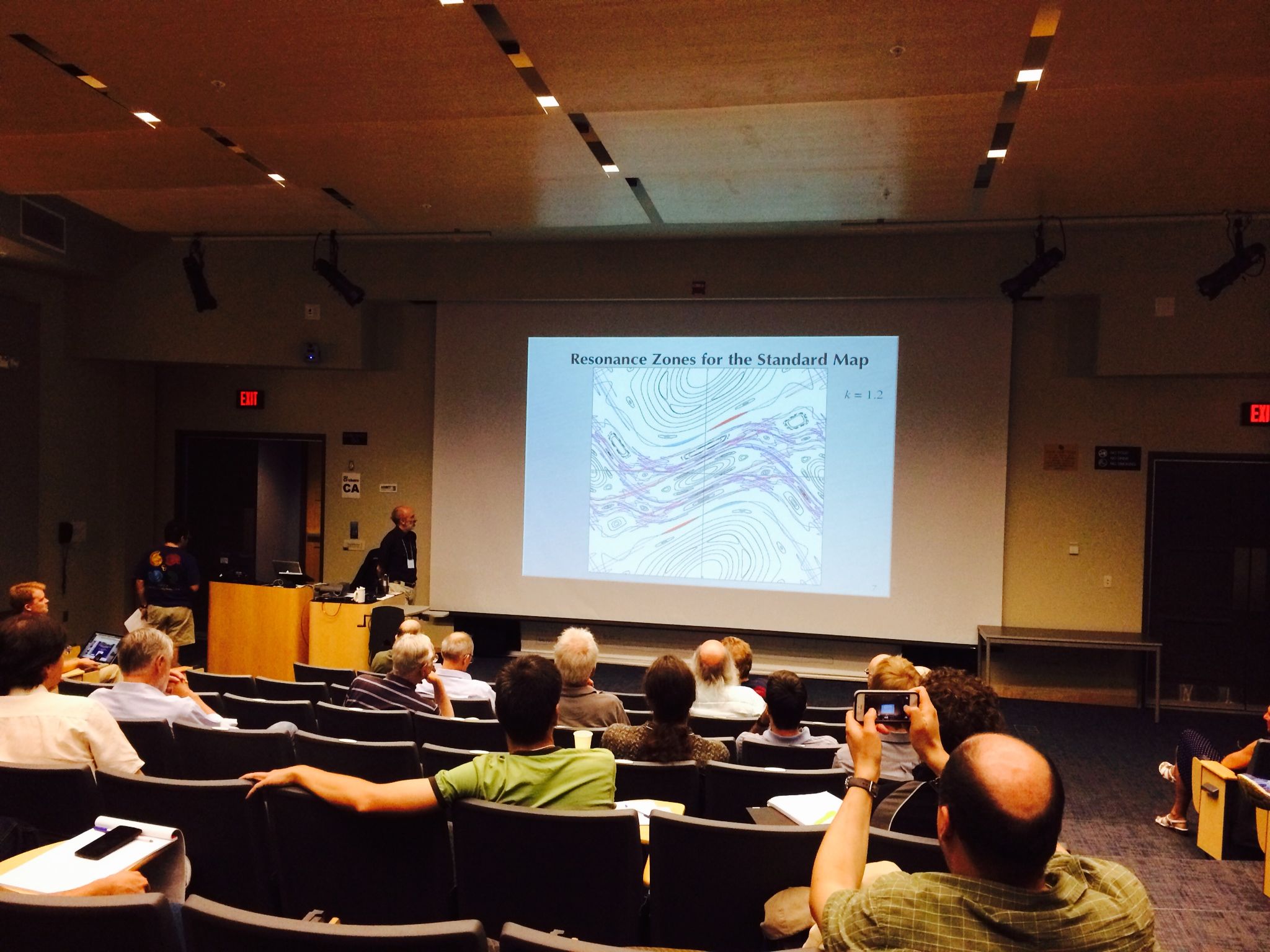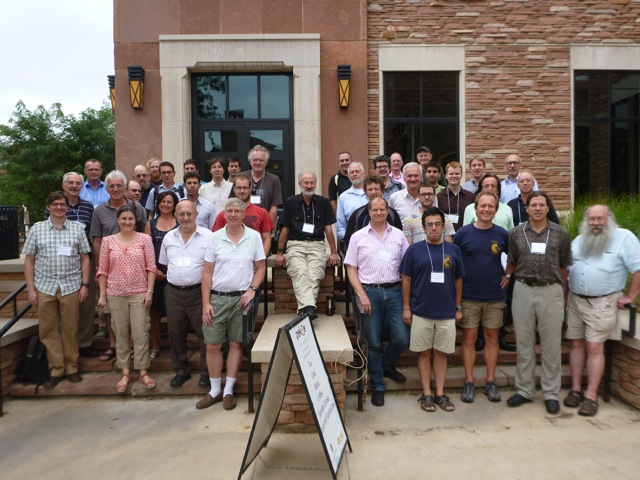From July 21-25 approximately 40 friends and scientists gathered in Boulder, CO, USA, for a very special conference, called Boulder Dynamics 2014, designed in celebration of the 60th birthday of Jim Meiss.
(Besides the program, I recommend to follow the link "Jim" on the site to read a lovely biography about Jim written by Bob Easton.)
This gathering was of course a dynamical systems conference, but it was also designed to honor a person who has been a quiet but unmistakable pillar of the community.

Jim Meiss presents his retrospective talk entitled "Thirty Years of Turnstiles and Transport."
Summer is always a glorious time in Boulder, and returning was a bit like coming home for me, as I am sure it was for many others who came, especially us former James Meiss PhD advisees. It was hot, no doubt, reaching the mid- and even upper 90's F. But true enough, it was a "dry heat." The flatirons towered as always over the familiar red-stoned campus buildings. Blue skies and scattered clouds gave way to the threat of scattered afternoon thunderstorms.

Jim Meiss in his native habitat - standing in front of a standard map displaying a resonance zone that causes the sticky diffusion effect we all know and love.
Sessions throughout the week were in the Roser ATLAS Center, a modern building in the center of campus with outer architecture and finish to match the rest. Roughly 40 participants from around the world, in addition to students and local friends, attended the meeting. It took place in what is rightly described as an intimate workshop-style setting, always in one comfortable sloping lecture-style modern room. The schedule ran from 9am to roughly 5pm most days, beginning Monday and ending at noon on Friday. It was nice that the breaks were substantial, with long coffee breaks and a long lunch break. This, I learned, was by design and to Jim's taste so that the meeting would have plenty of time for people to meet with each other and talk. The abundant breaks were especially nice at this conference, as they are at any meeting. Of note, this conference especially was both a meeting of fellow scientists and also a reunion of friends, who in my case were many former students and postdocs, some of whom I had worked alongside but had not necessarily seen in as much as 20 years. I could see I was not alone here. I also saw that there was a sense of reunion for many who were former students or postdocs and also other folks present at this special meeting, with whom Jim had shared his own early career.

The attendees of the conference with Jim Meiss front and center.
The size of the conference was intimate and allowed for longer-style 40-minute talks without the necessity of concurrent sessions. There were many interesting talks, of course with the theme being in dynamical systems, and by design we all had interests in this area. The centerpiece talk, centered in time at Wednesday at 9am, but, more importantly, centered in spirit, was the talk by James D. Meiss, the guest of honor. All hands were on deck as absolutely everyone was present for this talk. A lovely introduction was made by Robert Easton, a fellow professor for many years in the dynamical systems group in Applied Mathematics at the University of Colorado. Jim's talk was a retrospective starting from a significant early success, which I summarize here by repeating the title and a bit of the abstract: "Thirty Years of Turnstiles and Transport." "In the spring of 1983 in a small room of Queen Mary College, Ian Percival and two postdocs discovered that the strongest barriers to transport in area-preserving maps are the invariant Cantor sets that are remnants of the invariant circles predicted by KAM theory. These sets, named cantori by Percival, are fractal, but are typically hyperbolic and have zero dimension. Consequently it was a surprise to realize that they gave rise to impediments for the motion of chaotic orbits. Geometrically the flux across a cantorus can be localized to a region that they named a 'turnstile,' since it resembled a rotating door. Mathematically, the flux is computed as the difference in action between two orbits, a quantity that also is prominent in Aubry-Mather theory. An early success of the theory..." Indeed this work was immediately recognized and became integral in advancements in the understanding of chaotic transport as well as the next steps beyond KAM theory (see [1]). The relevance of this original work continues today, but it must be said since that paper thirty years ago, Jim Meiss has continued a sustained and recognized program of insightful and driving research, but also with centerpiece review works, including notably the Reviews of Modern Physics article [2] and several books including the textbook [3].
Other talks included several invited for the sake of their continuation of the theme of this landmark work, in mathematics or in physics as the work continues to be relevant today. These included, for example, talks ranging from celestial mechanics to quantum mechanics and also talks about modern perspectives of lobe dynamics. Also amongst the talks were many colleagues who, while continuing in dynamical systems, illustrated the richness of the field for its growing depth and topical applications over the years. For me, it was gratifying to learn of the personal stories behind many of the papers I was assigned to read as a student, but also a breadth of applications amongst folks, each and every one of whom showed what an important branch of mathematics and science dynamical systems has become. Disclaimer: I may have slipped, and allowed a bit of bias to sneak through.
Monday evening there was an outdoor reception at the Koenig Alumni Center (did I mention the lovely weather?) with wine, cheese and other yummies. Several of us stayed the full duration, as we closed down the place with the servers packing away the food. Tuesday there was a conference-organized group evening event at the Colorado Shakespeare Festival at the outdoor amphitheater, with an enactment of "The Merry Wives of Windsor" by the Great Bard of Avon. The dinner on Wednesday night was at the "Taj Restaurant," including the Indian cuisine buffet. On site, the meal concluded with what started as "embarrassing" stories from the past featuring Jim, but somehow degraded into testimonials by several former students who stood, one after another, to attest in heartfelt detail to what a supremely kind advisor they had enjoyed.
Thursday afternoon included a super session of the more senior folks, including Jim, who stood in a discussion session to lead thoughts on what the "next thirty years" might hold at this midpoint of sixty since "the first thirty had finished." Friday morning came surprisingly quickly and during coffee when I was talking to Jim we agreed that this was an especially quick week; I am sure that is a sign that it was a very successful conference. Here is to a hearty launch for the next thirty, and honors well deserved for JDM. Thank you to the organizers Holger Dullin, Bob Easton, Hector Lomeli, and David Sterling.
Eric Bollt
[1] R. S. MacKay, J.D. Meiss, and I. C. Percival, "Stochasticity and Transport in Hamiltonian
Systems," Physical Review Letters 52, 697-700, (1984); R. S. MacKay, J.D. Meiss, and I. C. Percival, "Transport in Hamiltonian Systems," Physica13D, 55-81 (1984).
[2] J.D. Meiss, "Symplectic Maps, Variational Principles and Transport," Reviews of Modern Physics, 64 795-848 (1992).
[3] J.D. Meiss, Differential Dynamical Systems, (2007) SIAM, Philadelphia 412 pp., ISBN 978-0-899816-35-1.